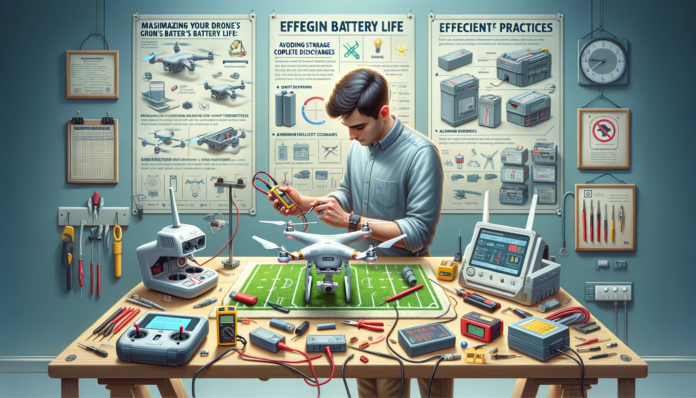In this article, you will discover practical tips and techniques that will help you maximize the battery life of your drone. Whether you are a professional aerial photographer or a hobbyist drone enthusiast, extending the flight time of your drone is essential for capturing those breathtaking shots and enjoying a longer flying experience. By implementing efficient practices, you can ensure that your drone’s battery lasts longer, allowing you to make the most out of each flight session. From optimizing flight settings to properly maintaining your battery, this article will provide you with valuable insights on how to maximize the lifespan of your drone’s battery. So, grab your drone and get ready to take to the skies while making the most of your battery power!
Factors Affecting Drone Battery Life
Battery Capacity
One of the crucial factors that affect the battery life of your drone is its capacity. Different drones come with different battery capacities, and it directly impacts the amount of flight time you can get. Higher capacity batteries generally allow for longer flight times, while lower capacity batteries may limit your flying experience.
Battery Age
Just like any other battery, the age of your drone’s battery can affect its performance. Over time, batteries tend to lose their maximum capacity, resulting in shorter flight times. It is important to keep track of your battery’s age and consider replacing it when necessary to ensure optimal performance.
Temperature
Temperature plays a significant role in the overall efficiency and lifespan of the drone battery. Extreme cold or hot temperatures can lead to a decrease in battery performance and lifespan. It is advisable to fly your drone in moderate temperatures to maximize your battery’s life and ensure optimal performance.
Flight Conditions
Flight conditions, including wind speed and altitude, can impact your drone’s battery life. Flying in windy conditions can cause your drone to exert more energy to maintain stability, thus reducing the battery life. Similarly, flying at high altitudes can put additional strain on the battery, leading to decreased flight time. It is essential to consider the flight conditions and make adjustments accordingly to conserve your battery’s power.
Pre-flight Preparations
Check Battery Health
Before taking off, it is crucial to check your drone’s battery health. Make sure the battery is fully charged and in good condition. Inspect for any physical damage or signs of deterioration. Regularly maintain and take care of your battery to ensure optimal performance and longevity.
Plan Flight Path
Planning your flight path in advance can help conserve battery life. By choosing a direct and efficient route, you can minimize unnecessary flying and reduce energy consumption. Consider using mapping tools or flight planning apps to help optimize your flight path and save battery power.
Avoid Excessive Weight
Excessive weight can put strain on your drone’s battery and significantly reduce its flight time. Avoid attaching unnecessary equipment or carrying heavy payloads unless required for your specific flight purpose. Keeping your drone as light as possible will allow for longer flight times and better overall performance.
Calibrate Compass and IMU
Properly calibrating your drone’s compass and IMU (Inertial Measurement Unit) before each flight can have a positive impact on battery life. Calibration ensures accurate flight control and navigation, reducing unnecessary energy consumption. Take the time to calibrate your drone’s compass and IMU to optimize flight performance and preserve battery life.
Optimal Flight Settings
Choose the Right Flight Mode
Different flight modes offer varying levels of battery efficiency. Opt for the mode that best fits your needs while also keeping battery life in mind. Some drones have specialized flight modes designed specifically for extending battery life. Research and experiment with different modes to find the one that suits your flight requirements and conserves battery power.
Avoid Excessive Altitude Changes
Frequent altitude changes during flight can consume more battery power. Try to maintain a consistent flight altitude whenever possible to minimize energy consumption. Avoid unnecessary ascents and descents unless required for your specific flight purposes. Consistency in altitude can lead to longer flight times and maximize battery life.
Control Speed and Maneuvers
Flying your drone at high speeds or performing excessive maneuvers can drain the battery quickly. Maintain a moderate speed and avoid unnecessary aggressive maneuvers to conserve battery power. Smooth and controlled flight movements will not only extend your flight time but also allow for more precise and enjoyable flying experiences.
Reduce the Use of GPS
The use of GPS during your flight can consume significant battery power. If you are confident in your piloting skills and have a good understanding of the flight area, consider flying in manual mode or disabling GPS when not required. By reducing reliance on GPS, you can maximize your drone’s battery life and prolong its flying time.
Efficient Takeoff and Landing
Avoid unnecessary hovering
Hovering consumes a considerable amount of battery power, especially if done for an extended period. Whenever possible, avoid unnecessary hovering by planning your flight path efficiently. Directly initiating movements after takeoff or before landing can help conserve battery power and increase overall flight time.
Use Aerobatics Mode
Some drones come equipped with an aerobatics mode that allows for quick and efficient takeoff and landing. By utilizing this mode, you can save valuable battery power by reducing the time spent in the air during these phases. Check your drone’s manual to see if it offers an aerobatics mode and how to properly activate it.
Utilize Precision Landing
Utilizing precision landing features provided by your drone can help conserve battery power during the landing phase. This feature allows your drone to automatically land precisely on a designated spot, reducing the need for excessive hovering or last-minute adjustments. Pay attention to the instructions provided by your drone’s manufacturer to ensure you are using this feature correctly.
Camera Operation
…

